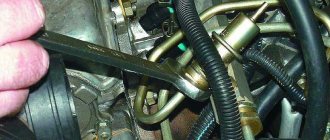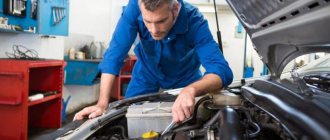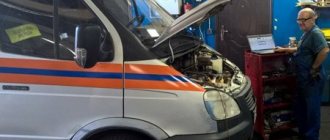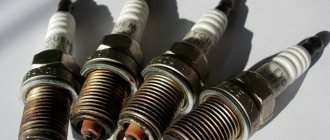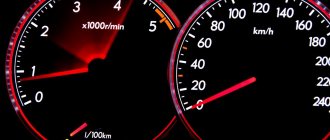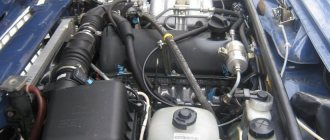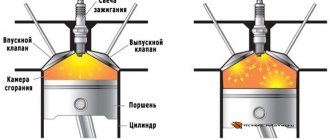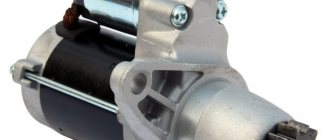When does this happen
Almost every car enthusiast who has logged more than tens of thousands of kilometers has encountered such a problem as uneven driving of the car, or, in popular parlance, the car simply jerks in some operating modes.
The car jerking can be as follows:
- the beginning of the movement;
- at low speeds;
- with increasing speed;
- at high speeds;
- in all modes at once.
Moreover, it is worth noting that such a malfunction occurs not only on an old car; a new car is also capable of twitching.
It is impossible to say that the cause of uneven running is only a certain part of the car and that it is unique to a specific brand of car.
Based on reviews from car owners, we can conclude that this problem occurs with absolutely any vehicle - an old VAZ “Seven” or a new “Japanese”.
The appearance of uneven movement of the car not only irritates the driver, but can also cause an accident, because at the right moment the car, instead of accelerating, will begin to twitch.
Let's try to figure out in detail what can cause the car to jerk while moving. But to do this, you first need to understand how everything happens.
Quick diagnostics
So, the car is started, the speed is turned on, the clutch is slowly released, and the engine speed gradually increases.
But instead of smoothly starting from a stop and starting to pick up speed, the car begins to jerk - the speed fluctuates, the speed either increases or drops sharply, despite pressing the accelerator pedal.
This can continue until either the twitching goes away on its own and the car begins to confidently gain momentum, or until the engine stalls.
It happens that the car starts moving quite safely, but as soon as the revolutions increase to 2000-2500, uneven movement begins, accompanied by sharp changes in engine operation, as well as in the speed of movement.
The same situation can be observed when reaching medium modes, that is, the engine reaches a certain speed level, after which twitching begins.
It happens that the car starts to jerk every time you change gears.
It is not necessary that uneven running occurs only under certain conditions.
It also happens that the car jerks spontaneously, without any frequency or conditions. That is, the car can jerk just once, in any mode, and then move normally for quite a long time.
Or the car was working normally, but suddenly began to twitch sharply, and this trouble no longer goes away.
In general, there are a lot of options, but one fact remains - the car has an uneven ride, and it is advisable to eliminate it as quickly as possible before the problem gets worse.
The first thing to do is determine under what conditions the twitching occurs. The easiest way to do this is while moving.
You should drive onto a flat section of the road where there is no traffic and start testing.
At first, just get moving, then gradually increase the speed, remembering the behavior of the car and watching the dashboard.
And this must be done until the engine reaches high speeds.
Afterwards, you will need to run the test again to make sure that the conditions for the appearance of twitching are determined correctly. And only after that you can start looking for the reason.
A summary table of the reasons why the car jerks for different types of motors for quick diagnosis.
| Causes | Car jerking while driving | |||
| Injector | Carburetor | On gas | Diesel | |
| The carburetor is clogged or faulty (clean, repair, replace) | — | + | — | — |
| Fuel and air filters are clogged (replace) | + | + | + | + |
| Gas filter clogged (replace) | — | — | + | — |
| Dirty injectors (clean, replace) | + | — | + | + |
| Malfunctions in the ignition system (check for serviceability of spark plugs, ignition coil, high-voltage wires) | + | + | + | — |
| Excess air enters the intake manifold, which is not taken into account by the ECU (identify and eliminate air leaks) | + | + | + | + |
| The TPS or throttle actuator has failed*** Examine the symptoms of a malfunctioning throttle position sensor. | + | — | + | — |
| Malfunction of sensors responsible for engine speed: Idle air control, absolute pressure sensor, mass air flow, accelerator, coolant temperature sensor. | + | — | + | +* |
| The contact point of the crankshaft sensor (crankshaft sensor) has failed or become clogged. | + | -/+**** | + | +* |
| Fuel pump malfunction | + | + | — | — |
| Problems in the operation of the injection pump (high pressure fuel pump), life expired, breakdown | -/+** | — | -/+** | + |
| Problems with the gas reducer | — | — | +/-** | — |
| Freezing of the gearbox or lines | — | — | + | — |
| Clutch wear, incorrect adjustment | + | + | + | + |
| Transmission problems (manual transmission, automatic transmission, CVT, robot) | + | + | + | + |
| Problems in the operation of the elements of the cylinder-piston group (failure in valve adjustment or malfunction, breakdown of hydraulic compensators) | + | + | + | + |
| Fuel that does not meet the requirements of the car manufacturer, its low quality | + | + | + | + |
* applies only to diesel engines that have a Common Rail injection system.
** applies to vehicles equipped with direct injection engines and 6th generation LPG with liquid gas injection installed on them.
*** for cars with an injection system equipped with an electronic e-gas pedal.
**** for carburetors of cars with an electronic ignition system.
Problem of supplying the engine with fuel and air mixture
A too lean air-fuel mixture is a fairly common problem that leads to serious engine malfunctions. Errors and disturbances in the mixture formation process can occur on carburetor or injection engines, as well as on power units with additionally installed gas equipment.
One of the main signs that shows deviations from the fuel assembly norm is unstable engine operation at low and idle speeds. As a result, the car begins to jerk and stall when starting to move.
For example, if a lean mixture is constantly supplied to the cylinders, the consequences can be quite serious. In a number of cases, the appearance of a white coating on the spark plugs and misfires have been noted; a lean mixture causes local overheating, burnout of valves and melting of the pistons.
General diagnostics of deviations from the fuel assembly norms begins with the ECM sensors. Typically, the P0171 code occurs due to a malfunction of the MAF sensor (mass air flow sensor). The fact is that the specified sensor ceases to respond in a timely manner to changes that relate to air flow. The cause is usually an accumulation of contaminants.
A poor fuel assembly of a car is the main reason why the car starts to twitch at low speeds
In this case, the control unit automatically reduces the fuel supply so that the amount of air increases. The result is a lean mixture at different operating modes of the power plant. After this, error P0171 occurs; in parallel, error P0100 or P0102 can be detected. Such codes usually indicate problems and malfunctions in the mass air flow sensor.
Car jerking at low speeds
This problem often occurs when driving at low speeds at low engine speeds.
Checking the engine power system
Often the reason for the car twitching at low speeds is the power system, or rather, a malfunction in its operation.
When starting to move, the required amount of fuel simply does not enter the cylinders; the car is unable to produce the required power to evenly operate the transmission.
At the same time, transmission resistance leads to uneven running.
When jerking occurs at low speeds, first of all you should check all the elements related to the power system, and it makes no difference what kind of system it is - carburetor, injection or diesel.
It is recommended to immediately check the condition of all pipes. Depressurization of the system almost always leads to air being sucked in, which leads to fuel starvation of the engine.
And only after checking the condition of the pipelines can you proceed to the remaining elements of the system, which will be discussed below.
Ignition system
Also, the cause of jerking at low speeds can be the ignition system, especially for injection cars, where the entire operation of the system is controlled and regulated by an electronic unit.
A malfunction of one of the sensors can easily cause the machine to twitch.
Electronics
In modern cars, the functioning of the power system is controlled electronically, so it is worth monitoring the serviceability of the mass air flow sensor (mass air flow sensor), the location of the throttle valve, and the condition of the idle air regulator. Often the car begins to jerk when moving from a standstill, when the TPS sends a signal to the engine control unit about the need to increase the volume of fuel supply. If the throttle valve malfunctions in the transient mode, there are jerks and dips.
At high speeds
But the jerking of the car at high speeds is more related to the ignition system.
In a normally operating engine, the ignition system automatically adjusts to certain conditions by changing the ignition timing.
That is, when necessary, the ignition becomes either a little early or late.
A malfunction in the automatic ignition will cause twitching.
Do not forget that the cause of uneven movement will be not only a malfunction of the system, but also the failure of one of its elements.
And these are only the reasons that can arise with the engine, without affecting the transmission.
You need to immediately narrow the search for identifying the reasons for the car twitching to two engine systems - fuel and ignition, but you should not discount the transmission.
Incorrectly set car ignition
Incorrectly set ignition is another common reason why a car starts to jerk at low engine speeds.
Signs of early ignition, as well as late, imply an advance or delay in the operation of the “ignition” system in relation to the position in which the piston is located in the cylinder. In other words, the spark plug ignites the fuel-air mixture not at the most optimal moment for this, but earlier or later.
This became the reason for the fact that in cars in which it is possible to adjust the ignition timing independently, car enthusiasts are often faced with the need for correct settings. How to determine whether ignition is late or early? The following is a list of signs by which an incorrectly set ignition is determined:
- Difficulty starting the power unit.
- The engine overheats and detonates.
- The accelerator pedal becomes less responsive.
- Unstable idle.
- The power potential of the engine is reduced, and throttle response is also lost.
Fuel consumption increases significantly. An incorrect OZ can also show itself in the form of specific pops that are heard in the carburetor, in the exhaust system, etc.
This leads to a very obvious conclusion: further operation of a power unit with incorrect safety regulation can lead to more serious consequences. The consequences will be especially negative if detonation occurs regularly.
Is it due to the fuel filter?
So, it has been determined that the car jerks only under certain conditions. The fuel system pipes are all normal, but it is believed that the cause lies in the fuel system.
This means that the filters need to be checked next. Often it is because of them that this malfunction appears.
The task of any filter element in the fuel system is to clean the fuel from impurities, but at the same time, these impurities do not disappear anywhere, they remain in the filter itself.
Over time, it becomes so clogged with impurities and dirt that its throughput drops, and greatly.
As a result, the fuel pump pumps as expected, but the fuel does not have time to pass through the filter elements and the engine begins to “starve”, accompanied by the car jerking. There is only one way out here - .
Carburetor cars
If you take into account a carburetor car, then the number of filters it has is 2-3 pieces, but one of them, the usual mesh on the fuel receiver, can be practically discounted.
This mesh is aimed only at catching large particles, so it is practically incapable of becoming clogged to such an extent that it stops the flow of fuel in the required quantity.
But the second filter, usually located in the pipelines leading to the fuel pump, is worth checking.
This filter is designed to catch smaller particles and is not difficult to clog.
The third filter is not available on all carbureted vehicles and is usually located at the fuel inlet to the carburetor. It is also a regular mesh, but only fine.
This filter itself is small, so it often gets clogged.
Older machines had another filter installed - a coarse filter, also known as a sediment filter.
The design of this filter is such that it is not capable of becoming clogged to such an extent that it will not allow fuel to pass through. But this filter will subsequently cause rapid clogging of the fine filter.
If this filter accumulates a large amount of debris and dirt, then eventually it will not begin to clean the fuel from impurities, but, on the contrary, will begin to add them.
Injection car filters
Most modern injection cars are also equipped with three filters.
- The first of them is a mesh for catching large particles installed in the neck of the tank. This mesh is clearly not the cause of the twitching.
- The second filter is located on the fuel pump installed in the tank. This filter is also often a mesh, only with smaller cells; its task is to prevent large debris from entering the fuel pump. It is also unlikely that it can cause a lack of fuel.
But the third filter, a fine filter, is located behind the fuel pump and is quite capable of becoming clogged to such an extent that the pump cannot push the required amount of fuel through it.
On more modern cars, there may be additional filters, which can also cause the car to twitch.
Other elements of the fuel system
Now on to other elements of the fuel system.
Fuel pump.
The next culprit for uneven running may be the fuel pump.
In carburetor cars.
A mechanically driven diaphragm fuel pump is often used here.
So, even a small rupture of the membrane will cause the pump’s performance to drop sharply.
The pump valves may also be to blame. They can easily break the sealing of the device’s chambers, which leads to a drop in fuel supply.
Injection car.
The fuel pump can also cause jerking. On such cars, since the pump is located in the tank, it is electrically driven.
A decrease in device performance leads to the problem described in this article. Here you need to consider a specific case separately.
Now directly about the carburetor.
Because of this, uneven running of the car is also possible. Often such a malfunction occurs due to severe clogging. Debris and dirt can block channels, clog jets, etc.
Sometimes the reason lies in the accelerator pump. A diaphragm accelerator pump is installed on carburetors, the task of which is to increase the fuel supply when the gas pedal is sharply pressed.
But if the membrane is torn, then the accelerator pump will not be able to increase the supply of gasoline, and hence fuel starvation.
Injectors.
For injectors, the fuel injectors are checked next. Violation of their performance leads to jerking of the car.
Injectors need to be cleaned periodically, in principle, like everything else.
Also, in an injection car, the functionality of all sensors involved in the operation of the power system is checked, and then the electronic control unit is checked.
Throttle position sensor problems
The car “stumbles” when you press the gas - the throttle valve opens or closes late. The DPS is responsible for its operation.
The sensor reads the information and sends it to the control unit so that the engine increases or decreases speed. The damper supplies the required amount of fuel, and the pressure in the ramp increases.
The car jerks violently when the driver presses the gas pedal lightly. The reason is the sensor, which transmits information to the control unit with a delay. The damper is slightly open and when fuel enters, it cannot cope with its main function. The motor “troits” and jerks.
The throttle position sensor needs to be replaced with a new one. Repair is useless - the effect will not last long.
Let's go through the ignition system
The first thing that is checked in this system is the candles.
There have been cases when a car enthusiast replaced old spark plugs with new, and expensive ones at that, and ended up getting irritated due to the car jerking. But since the candles were new, he did not bother with them, but looked for a different reason.
This problem often occurs due to incompatibility of the spark plugs with the engine.
But their long-term use gives the same result. The spark plugs may fail, there will be gaps in their operation, and as a result, the fuel will not ignite well and may not burn completely.
In general, if the fuel system test fails, the next thing to check is the spark plugs. In this case, the candles themselves can suggest the cause of the malfunction.
At home, you should immediately check the gap on unscrewed spark plugs. Failure to do so will result in disruption of sparking. Then the spark plug is checked for sparking.
In a normally working spark plug, the spark should be powerful, purple in color and there should be no gaps in its appearance.
A faded orange spark, and even with gaps, will signal a malfunction of the spark plug or other element of the system.
Soot on the candle will tell you where the cause is hidden. If there is black carbon deposits on it, then either the ignition on the car is broken, or the mixture formation in the fuel system is disrupted, and this can already cause the car to jerk.
But you should not immediately, having determined that there are gaps and the spark does not correspond to the norm, blame the spark plugs for everything. It is quite possible that a weak spark is a consequence of a faulty connection in the system wiring or failure of one of the ignition elements.
Therefore, the second is to check all the wiring of the system for breaks, oxidation of contacts, and the presence of breakdown. And only after this the remaining elements are checked - the coil, the distributor, the switch.
Damage to the accelerator (gas pedal)
Mostly, problems with car jerking at low speeds are associated with electrical circuits. The pedal support is equipped with a pair of sensors. Their task is to transmit signals for changing the accelerator position.
There is an indicator on the panel that will indicate a system malfunction. If one sensor is damaged, the engine speed increases at a low speed. If both devices break down, the emergency mode is activated and the engine runs at idle.
As a result of a breakdown, the pedal must be replaced, since the sensors cannot be restored. Loss of wiring integrity leads to a malfunction of the throttle. If the electric motor becomes unusable, the information on the monitor will display an error indicating an accident. These problems can be easily solved. If the accelerator of the electronic gas pedal breaks down, it is replaced with a new one.
About the transmission
Now a few words about the transmission, since it can also cause jerks when driving.
As you know, cars use manual and automatic transmissions.
As for a manual transmission, the gearbox and everything that follows it cannot cause jerking.
A manual transmission is a fairly simple design, and if it already breaks, it breaks specifically, and not creating jerks.
But the clutch can cause jerking. If it is heavily worn, in particular the driven disk, or “slips,” then the car easily begins to twitch.
But as a rule, jerking and twitching with such malfunctions occurs during gear shifting.
In automatic transmissions, the cause of the jerking is the gearbox itself.
It is very dependent on the quantity and quality of oil, so a lack of oil or its foaming can easily cause uneven running of the car.
You can measure the oil level in the automatic transmission using a dipstick.
Or without.
It all depends on the design of the automatic transmission.
How to measure the oil level in an automatic transmission.
Significant wear of the automatic transmission, as well as clogged oil channels, also causes the car to jerk at all speeds.
Why does the car jerk while driving?
Various malfunctions associated with the operation of the engine, transmission and attachments can occur both at idle and under load while driving, as well as in transient modes. Failures can often be identified by the presence of obvious leaks of technical fluids, increased noise, obvious knocking, unstable operation of the internal combustion engine, failures, etc. Next, we will look at the possible reasons why a car with an injector begins to twitch while driving, that is, noticeable jerks appear.
Jerks on the gas
There are often situations when the car jerks when driving on gas, but everything is fine on gasoline. The cause may be problematic spark plugs or high-voltage wires.
But why then does the malfunction appear only on gas fuel?
The bottom line is that when using gas fuel, the breakdown requirements are higher than in the case of gasoline. It turns out that the spark follows the path of least resistance and, accordingly, not in the place where it is needed.
As a rule, this happens when the gas pedal is sharply depressed, when the mixture is lean for some period and it is during this period that the breakdown energy increases.
To confirm or refute the version, you can remove the spark plug and look at the condition of the white dielectric.
Sometimes the symptoms are visible directly on it, but there are situations when the breakdown occurs internally. In this case, the check is carried out only at the stand.
It happens like this:
- Breakdown.
- The spark plug does not “receive” a spark or the latter is very weak (we write in easy-to-understand language).
- The fuel-air mixture does not ignite and the cylinder is excluded from the engine operation.
- The power drops cyclically and the car starts to jerk.
After eliminating the malfunction in the ignition system, the jerking when operating on gas should go away.
Some car owners complain that after replacing all the ignition elements, nothing changes. But at the same time, they ignore the requirements of engine manufacturers about the permissible type of installed spark plug.
In some cases, reducing the spark plug gap may help.
There are also situations when gas and gasoline enter the same injector due to an error by the adjusters.
"Personal" motives
The cases listed above are the main reasons why the steering wheel twitches when driving a VAZ-2114. Moreover, this is observed when starting or accelerating. However, it should be taken into account that each vehicle has individual characteristics, which are comparable to the human body.
In other words, each car has its own “diseases” and the appearance of the “symptom” in question is precisely due to the presence of design flaws.
Sooner or later, every car enthusiast encounters this phenomenon: the engine suddenly starts running jerkily, the car seems to twitch. This can happen at any time. When accelerating, sharply pressing the gas pedal and even at idle. We will talk about why this happens and how to deal with it in this article.
Vibration and jerking when reversing
There are situations when the car jerks while moving in reverse, and vibrations are also possible.
Here you need to consider which gearbox is installed.
If your car has an automatic transmission, you need to pay attention to the position of the engine protector.
It is possible that this element of the car was installed incorrectly when filling oil or performing other work. In this case, the exhaust pipe is close to the protection.
When you engage reverse, the engine tilts slightly, which causes vibration.
It is also necessary to pay attention that there are no touches along the entire perimeter.
If necessary, thick rubber seals must be installed.
There are also other possible reasons that are relevant for all cars:
- Nedogazovka. It is necessary to take into account that the reverse speed is higher than the first, therefore, at low speeds (about 800-1200 rpm), twitching may appear, and the car itself does not have enough strength to accelerate. Almost the same principle applies here as with the second speed.
- Poor contact. When moving backwards, the engine tilts a little. If there is a poor connection in the wiring, the situation gets worse when the reverse gear is engaged.
- Suspension. Even in ideal condition, this component gives a certain vibration.
- Severe wear on the differential.
- Low-quality CV joints or “shifters”.
- A worn clutch or some kind of defect if we are talking about a new car. More precisely, the basket presses the disc unevenly onto the flywheel.
- Wedging in the basket.
- Problems in the gearbox, namely the reverse gear.
Much depends on the car model. To determine a more precise cause, it may be necessary to check each of the presented versions. But it is better to contact experienced service station employees.
Automatic transmission
The situation when a problem with jerking occurs on an automatic transmission deserves special attention.
In this case, the following reasons are possible.
Control block
ECU malfunction is one of the causes of shocks when switching automatic transmissions.
Depending on the make/model of the car, the electronic unit can be independent or built into the “brains” of the engine.
To solve the problem, the ECU may need to be replaced.
Motor sensor
The cause of jerking when driving a car with an automatic transmission may be a malfunction of one of the control bodies, for example, or the mass air flow (MAF).
In such cases, the engine error may not light up. For example, on Ford Mondeo cars with a 6-speed automatic transmission, the problem may arise due to a breakdown that affects the change in torque.
Solenoids
Failure of these elements in the valve body often leads to jerking of the machine. In this case, the culprit is often the valve responsible for oil pressure.
Most often, it needs to be replaced to solve the problem. This situation is typical for automatic transmissions of the DP series (France).
Automatic transmission wiring harness
Wear or damage to this component causes many problems.
That is why during a major overhaul this unit is replaced first.
Mechatronics board
Some automatic transmissions have a separate unit that controls the solenoids. It is mounted in a tray, and if it breaks, it leads to many problems with the automatic transmission.
A similar component can be found in the Mercedes-Benz 722.9 with a seven-speed automatic transmission or in the six-speed “box” of the GM 6T30 and 6T40.
Hydraulic block
A decrease in oil pressure in the automatic transmission hydraulic system leads to jerking and may occur due to failure of the valve body.
The reason may be normal aging or bending of device elements due to overheating.
Problems with hardware
The worst thing is if the malfunction is caused by mechanical malfunctions of the transmission elements. In this case, disassembly and repair may be required.
For example, in Audi cars with a six-speed automatic transmission, the drum bushings often wear out.
As a result, oil is supplied to the friction pack, and due to lubricant leakage, slipping occurs, and the discs literally “burn”.
Other reasons:
- Reduced oil level. It is enough to reduce the volume of lubricant by only 500 ml for twitching to appear.
- Problems with automatic transmission and engine mounts. If there is excessive wear, the engine tilts, which causes jerking.
- Overheat. The problem may arise when operating vehicles in hot weather when the radiators are dirty and the thermostat is faulty.
This list can be supplemented with a problem with the housing and wear of the band brake rod attachment point.
As a result, an oil leak appears and there is a decrease in pressure in the system, followed by a shock.
Mazda 6 owners faced a similar problem.
Automatic transmission Mazda 6
If difficulties arise in the operation of the automatic transmission, it is important not to delay repairs, but to immediately go to a service station for inspection.
If the cause of the car jerking in motion is mechanical problems, you will have to remove and disassemble the “box”.
But most often it does not come to this, and the issue can be resolved by restoring the electrical part.
Maybe it's all about the checkpoint?
Another version of why the VAZ-2114 twitches while driving affects the transmission mechanism. As a rule, this behavior of the car can be caused by improper operation of the engine and lack of regular maintenance of automatic transmissions. With the total mileage of the car from 100 to 200 thousand km, you should not be surprised at its jerks.
Moreover, even if the box looks good on the outside, it doesn’t mean anything. This is mainly due to excess and lack of transmission oil - it will begin to foam, which leads to twitching.
It is worth paying attention to the following elements:
- Are the fastenings loose or is there damage to the drive cable?
- The shift rod may be damaged.
- The locking device is worn out or deformed.
- The gear fork is worn out.
It is these elements that are responsible for starting the car to move. Therefore, when a VAZ-2114 car jerks, they are also checked first. Fortunately, repair work on the box does not take too long. In a car service center, they will remove and restore the mechanism in almost a couple of hours.
Checking VAZ-2107 carburetor
Now let's take a closer look at how to identify the cause of such a malfunction on different car models.
The first will be the carburetor VAZ-2107; there are plenty of cases when the car suddenly starts to jerk while driving.
As already mentioned, you need to start checking with the fuel system:
- First you need to inspect all pipes of the system for cracks;
- Open the tank. It happens that in the summer the lid fits very tightly to the neck, blocking the access of air to the tank. When moving, the pump works and creates a vacuum in the tank, due to which the same pump is then unable to “pull” fuel. It seems like a small thing, but this also happens;
- Inspect the fuel filter located in the pipes leading to the fuel pump. These filters are transparent and easy to visually evaluate;
- You can also check the fuel pump without removing it. It is necessary to disconnect the pipeline coming from the pump from the carburetor and lower its end into some container. Then manually pump the pump into action and evaluate how it pumps fuel - it should supply it in even portions;
- While the fuel pipe is disconnected from the carburetor, unscrew the fitting on which the fuel line fits and remove the small mesh filter, clean it and reinstall it;
- Next comes the carburetor. It is advisable to remove it from the car, rinse it thoroughly, and inspect the accelerator pump membrane.
If actions with the fuel system did not help, we proceed to checking the ignition system.
- We unscrew the spark plugs, check their functionality, and replace them if necessary;
- We check the system wiring for breakdown. This can be done this way - in the dark or in a closed garage (the main thing is that it is dark), open the hood and start the engine. If there are voltage losses on the wiring, they will be immediately noticeable by the sparks that form. Next, we replace the wiring that “breaks through” and check the wire connections;
- Next, we check the distributor, there should be no signs of critical wear, it should be dry under the cover. Be sure to inspect the centrifugal regulator, and also check the vacuum regulator. You should check whether there is a vacuum in the pipe leading to it.
- Then the Hall sensor, coil and switch will be checked for functionality. You can do this yourself if you have the necessary equipment at hand, but you need to know how to check them. But you can contact an auto electrician.
- It is also important not to forget to check that the ignition is installed correctly.
This is in general and all the features of identifying the cause of uneven running on the VAZ-2107.
Checking VAZ-2110
Let's move on to a more modern car - the injection VAZ-2110, which can also twitch when driving.
It’s also worth starting the check with the power system, but it is carried out somewhat differently than on the “Seven”:
- Start with the fuel filter and pump. The filter there is non-separable and diagnostics are done by checking the performance of the pump. It is impossible to carry out the work at home; it is better to contact a service station. There, a special device is connected to the outlet of the fuel filter to measure the outlet pressure. If the pressure does not correspond to the norm, then another measurement is taken, but the device is connected to the fuel pump before entering the filter. This way it is determined whether the insufficient fuel supply is due to the filter or the pump;
- Then the functionality of the injectors is checked. If everything is in order with the specified elements, then the check of the electronic component begins;
- First, all sensors are checked for serviceability and functionality; if they are serviceable, then all that remains is to check the control unit;
- The control unit can often cause jerking if its firmware is broken, that is, it does not operate in the mode it should.
Usually such a malfunction is “cured” by “reflashing”, but if there is internal damage in it, then it is replaced.
As for checking the ignition system, it is in many ways similar to checking the VAZ-2107 system.
It all starts with the spark plugs, then the wiring is checked, then all the components, but taking into account the fact that this system is controlled by an electronic unit that controls the operation of the engine using sensors.
So, when checking the ignition, you will also have to check the performance of the sensors and the unit itself.
Malfunctions in the carburetor chamber and pump
If a car with a carburetor jerks when you press the gas, you need to check the chamber.
The outlets often become clogged. The fuel enters the engine with contaminants, the mixture is bad, and the engine cannot operate normally. To eliminate the problem, it is enough to clean the pipes with compressed air, initially dismantling the carburetor.
Sometimes the accelerator pump becomes unusable. Not all the mixture enters the engine, the power unit is “starving”, unstable, and operates jerkily. The pump can be accidentally damaged during repairs due to the inconvenient location of the device. The part is useless to repair; you should purchase a new one.
Carburetor chamber diagram
VAZ 2114 injector
Owners of VAZ 2114 cars with an injector often complain about the appearance of car jerking and loss of traction. The first thing you need to do is connect to the diagnostic connector and look for errors.
The most common problems that may occur are:
- P0327 - knock sensor, low voltage;
- P1602 - unstable voltage;
- P2127 - gas pedal position sensor, low voltage;
- P2138 - gas pedal position sensor, signal mismatch.
In this case, you need to look at what error Check appears. Most often this is P2127, so this is what you need to pay attention to.
After connecting, you need to look at the information that the sensors provide when you press the gas.
If after pressing the accelerator the indicators change significantly, this may indicate a violation of the resistive layer.
The following steps may be required to resolve the issue:
- Take off the gas pedal.
- Loosen the mounting screws.
- Remove the cover.
- Wipe the circuit with an alcohol solution.
- Reassemble the pedal and put it in place. Don't change your position.
- Take measurements using a potentiometer.
If the data is static, and after releasing the gas the voltage parameters do not change, this indicates a solution to the problem.
Also look at the knock signal for different cylinders. If any of them has a low parameter, this may indicate a problem with the sensor and the need to replace it.
Lada Kalina, VAZ 21099
When operating the Lada Kalina, jerking may occur when driving. They can occur when starting off, during acceleration, or during normal driving.
In most cases, to identify the cause, you need to diagnose the ECU at a service station, but there are situations when you can solve the problem yourself.
Below we will consider possible solutions for different situations that can be applied to other cars, for example, VAZ 21099 injector.
When starting to move
The reason is the slow response of the engine to pressing the accelerator. A jerk appears at the moment the throttle opens, when the sensor of this unit transmits information to the ECU.
Next, the electronic unit determines the moment of transition from the idle mode to the load and makes a decision to add fuel.
When there is a shortage of pressure in the fuel supply system, jerking occurs.
During acceleration
Here the reason is the same as in the case discussed above. When you press the gas, due to lack of pressure, less fuel is supplied to the engine than necessary.
While driving
Such problems are often caused by breakdowns in the ignition system. To check the version, do the following:
- open the hood;
- turn off the ignition;
- check the quality of the wires;
- start the engine and listen to it for the presence of a crackling sound/breakdown;
- change the spark plugs and inspect their condition, and if problems are identified, make repairs.
The cause of jerking when driving the Lada Kalina may be a breakdown of the sensor that displays information on the throttle valve.
The problem can be identified by uneven operation of the motor and a decrease in its power. The only way out in this case is to replace the faulty element.
Electrical problems
The car engine stops running while driving due to electrical problems. Initially, you need to check all the masses.
The battery terminals may not be secure enough; if the connection is poor, no power will be supplied; this is a rare problem.
You need to check the generator connections. After repairs, the repairman may forget to tighten the terminals, and the device will not charge. The battery will be completely discharged and the engine will stall while driving. The location of the generator for the VAZ-2115, 2110 and 2112 models is similar.
The generator could fail or the belt could break. This is indicated by an icon on the dashboard. It is recommended to visit a car service; repairing it yourself can be harmful.
You should check the ground that goes from the negative of the automatic transmission to the engine. For prevention, the terminals are cleaned and lubricated with a special compound.
The reason is faulty high-voltage wires. Can't be repaired - needs to be replaced.
Faulty ignition coil
When the ignition coil is not functioning, the engine periodically stalls. There is increased fuel consumption, a drop in vehicle power, and poor engine starting.
The power unit begins to “triple”, especially in the rain, the speed is uneven. A breakdown is indicated by an indicator on the dashboard.
To verify that the coil is faulty, you must:
- When “triple” occurs, remove one coil at a time. If you remove the good one, the speed will begin to “float” more; eliminating the faulty one will not change anything.
- If the part does not function, the spark plug will be wet, with a black coating, and the resistance will differ.
Attention! VAZ cars with an 8-valve engine have an ignition module, the role of which is similar to that of coils.
Vacuum brake booster
The power unit stops working when you press the brake - the problem is in the vacuum booster. The device is connected by a hose to the intake manifold.
A faulty membrane cannot create a vacuum at the right moment when you press the brake pedal. Air flows enter the working mixture, which becomes lean. The engine cannot run on such a mixture, so it stalls.
To fix the problem, it is enough to change the gaskets and membrane, and sometimes the hose.
Faulty air duct corrugation
On cars with an injector engine, the cause of the problem may be a depressurized (usually torn) air duct corrugation. Air flows past the mass air flow sensor, incorrect information is sent to the control unit, the mixture changes, and the engine stops working.
The engine “troits” even at idle. To eliminate the breakdown, it is enough to change the corrugation.
Lambda probe
The sensor is necessary to analyze the oxygen content in the exhaust gases and check the quality of the mixture. Failure of the device is the reason for poor engine starting, interruption of operation and reduction in power. Fuel consumption also increases. You can verify that the problem is related to the device by performing diagnostics.
Faulty Lambda probe
Sensors
Cars have many sensors. If one breaks down, the vehicle begins to act up, the engine may “trouble.”
Often the engine stops working due to the crankshaft timing sensor. If the part fails completely, the car will not start. Due to problems in the device, the power unit will operate unevenly and periodically stall.
The sensor may overheat.
Illiterate firmware
Car owners often have their vehicles flashed. This procedure allows you to unlock the potential of the engine and improve dynamics.
In order to save money, car enthusiasts make the firmware cheaper. As a result, the car goes further faster and stalls when the speed drops. The control unit confuses the readings and supplies the working mixture in different ways.
It's worth resetting to factory settings. When flashing, you need to choose a good specialist with extensive experience - incorrect settings can cause great harm.
Opel Astra
A common problem is the appearance of jerking while driving an Opel Astra. In this case, the malfunction most often appears after the engine has warmed up to 50 degrees Celsius.
The first thing to do is to carry out diagnostics and count errors. During the assessment process, it is necessary to look at the injection timing and EGR sensor/valve performance.
After that do the following:
- Warm up the engine to operating voltage.
- Check the voltage at the EGR contacts (there are five in total). To solve this problem you need to use needles. There should be about 14 V on the outermost contacts, about 5 V on the second one from the windshield, and on the third one there should be from 0.65 to 2.0 V.
- Check the wires that go to the EGR.
- Make sure the valve is intact. Perhaps it has malfunctioned.
- If the valve and wires are intact, only the ECU remains. It is necessary to open the block and see what problems there are.
Checking Ford Focus
The last car will be the Ford Focus 3 injector, which is not surprising, but it can also twitch when driving.
Note that the sequence of checking the ignition and power systems on this car has the same algorithm as on the VAZ-2110. But let’s assume that our car is equipped with an automatic transmission, and no problems were found in the engine systems.
As for checking the automatic transmission, you can only check the oil level yourself, but you need to know how to do it correctly.
A more in-depth check can only be done on the service. There, using special stands, they will first check the performance of the engine, and then diagnose the operation of the automatic transmission.
Also read about the reasons why.
